Schefflera Plant - How to Care for an Umbrella Tree?
Schefflera is a popular houseplant. If you take a good care of it, it will grow beautifully for many years. The results surprise even those who already own various exotic plant species in their collection. Are you wondering how to care for an umbrella plant? Do you want to know if it needs a lot of sunlight? Find the answers to these and other questions in the text below.
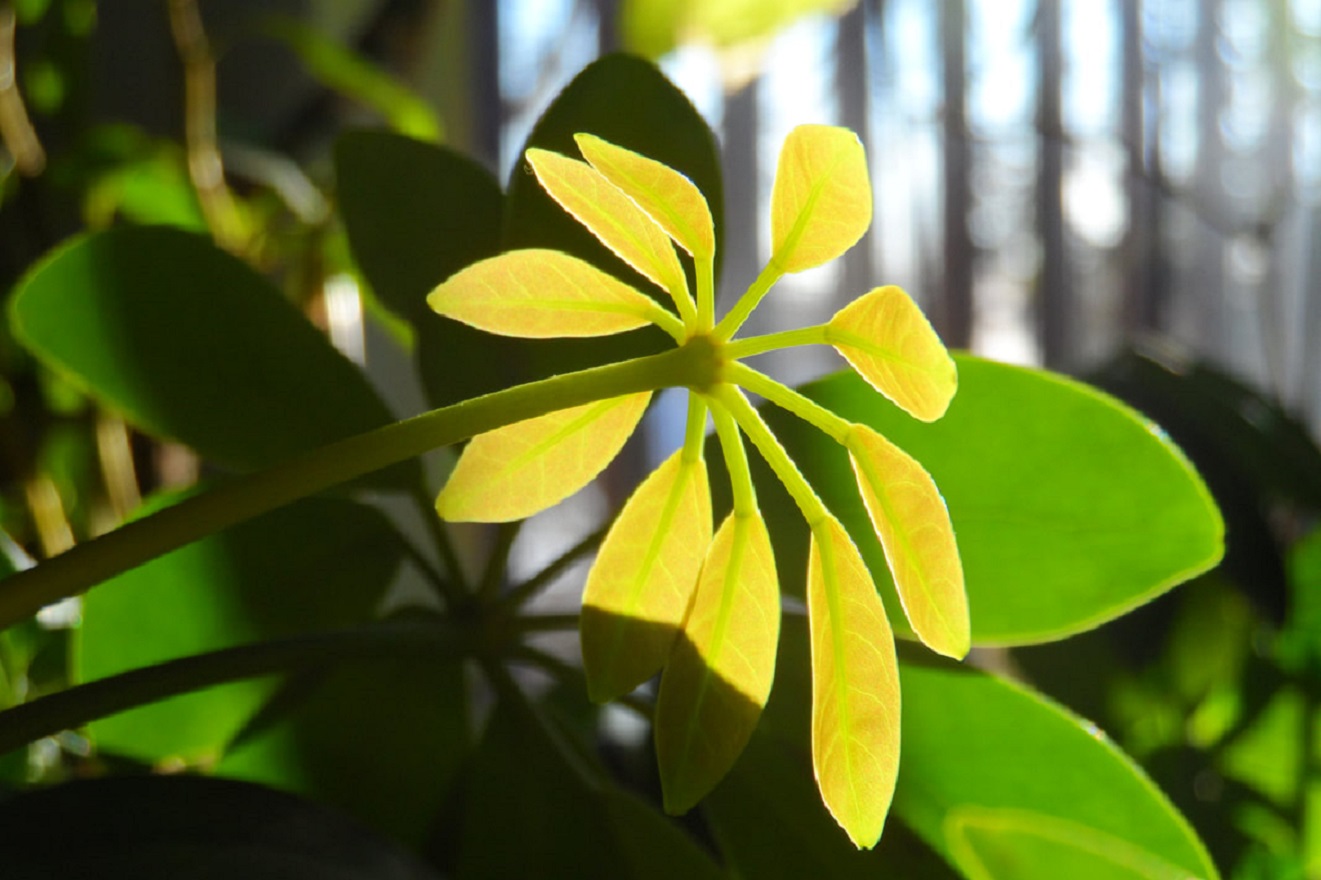
Schefflera - what kind of plant is it?
Schefflera, also known as umbrella tree and octopus tree, is an extremely easy to grow plant. It belongs to the group of potted plants with a bush-like appearance. Originally, it comes from Australia and New Zealand. It can reach a height of 3 meters when growing in its natural habitat. In colder climates, it’s typically half smaller.
Umbrella tree is an excellent plant for bedrooms. Are you wondering why? Mostly because of its features. This plant can absorb harmful substances that pollute the air.
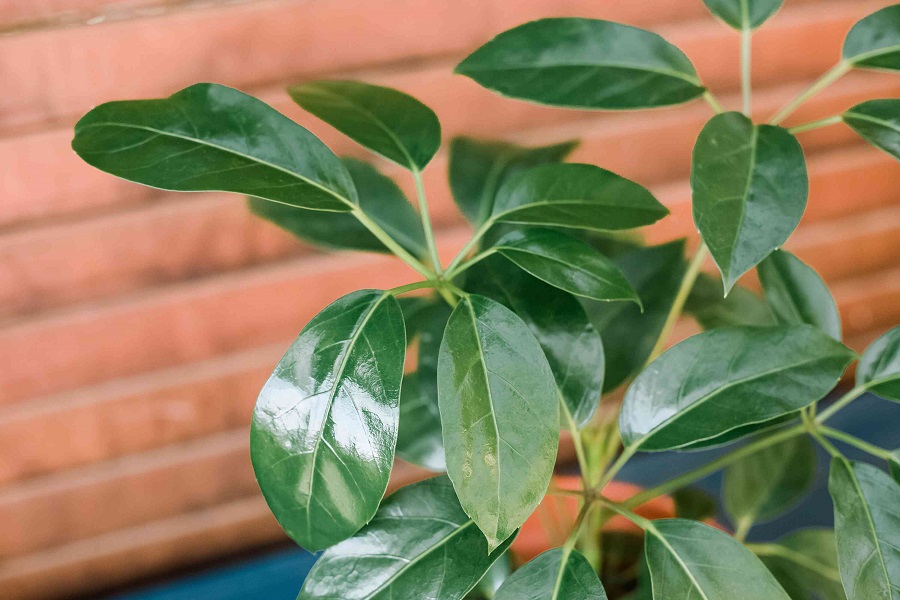
Popular types of umbrella tree
There are many varieties of schefflera plant. They differ only slightly between each other. Thanks to this, you can decide on which type to pick so that it fits the interior where it’s going to grow. The most popular umbrella tree types include:
- arboricola,
- arboricola ‘Gold Capella’,
- arboricola ‘Janine’,
- arboricola ‘Trinette’,
- arboricola ‘Luseana’,
- alpina,
- actinophylla ‘Amate’.
The main difference between these varieties is in their height. Additionally, colors and size of their leaves might also be different.
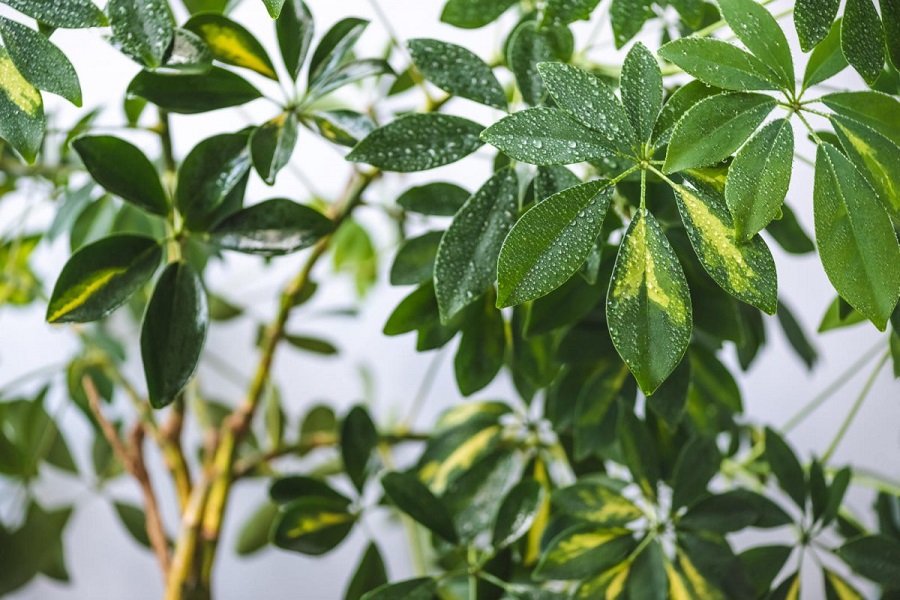
Schefflera plant - sun or shade?
Schefflera trees aren’t very demanding. They can grow in sun, as well as half-shade. Keep in mind that an umbrella tree exposed to strong light develops smaller leaves with shorter stems than a plant growing in half-shade.
Avoid placing the plant in full shade. In this case, there’s a risk that the schefflera will drop all its leaves.
When picking a place, pay attention to an important aspect - the type of the schefflera you own. If its leaves are spotted, it means it prefers growing in sun.
The optimal room temperature for an umbrella tree is between 18 and 25 Celsius degrees (64.4-77°F). Make sure to keep an equally stable temperature in winter as well - but preferably not higher than 18°C. A temperature lower than 12°C (53.6°F) might cause the plant’s leaves dropping.
What is the best soil for an umbrella plant?
Growing a schefflera requires providing proper soil conditions to the plant. The soil in the container should be very fertile and rich in humus. It also has to be permeable so that it doesn’t accumulate water in the pot. It’s because the plant prefers moderately humid soil. Water standing in the container might harm the octopus tree.
The soil pH has to be slightly acidic. You can prepare a soil mix yourself or purchase one in a gardening store. The latter solution is the best option for beginner gardeners.
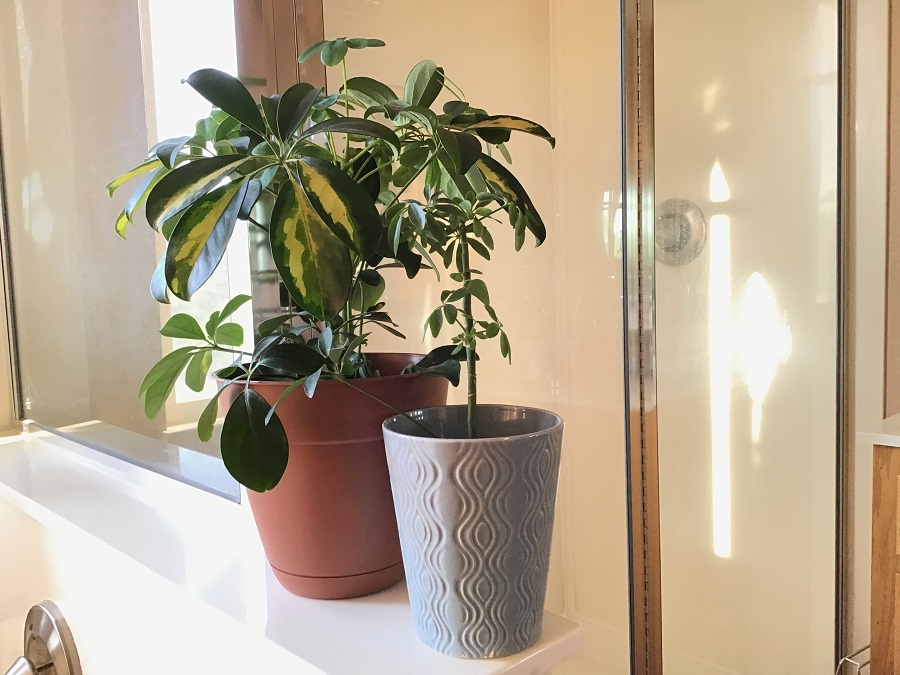
Umbrella plant - watering
Are you wondering how to water a schefflera tree? The plant prefers only slightly moist soil. Water it sparsely 2-3 times per week. This concerns umbrella tree care in summer.
You can limit watering in winter to once a week. But make sure the soil is never overly dry - if this happens, you’ll notice leaf damage in the form of small bubbles on the surface. An overly dry umbrella tree loses the color of its leaves - they become yellow and then fall off.
Too frequent watering of a schefflera plant might cause issues with the root system. They might begin to rot, and the consequences are difficult to reverse.
Schefflera tree care - feeding
Umbrella plant requires feeding, especially in spring and summer. Use a multi-ingredient liquid fertilizer when watering the plant. Feeding the plant every two weeks is just enough. A lack of needed nutrients in the soil might be the reason why the leaves of an umbrella tree yellow.
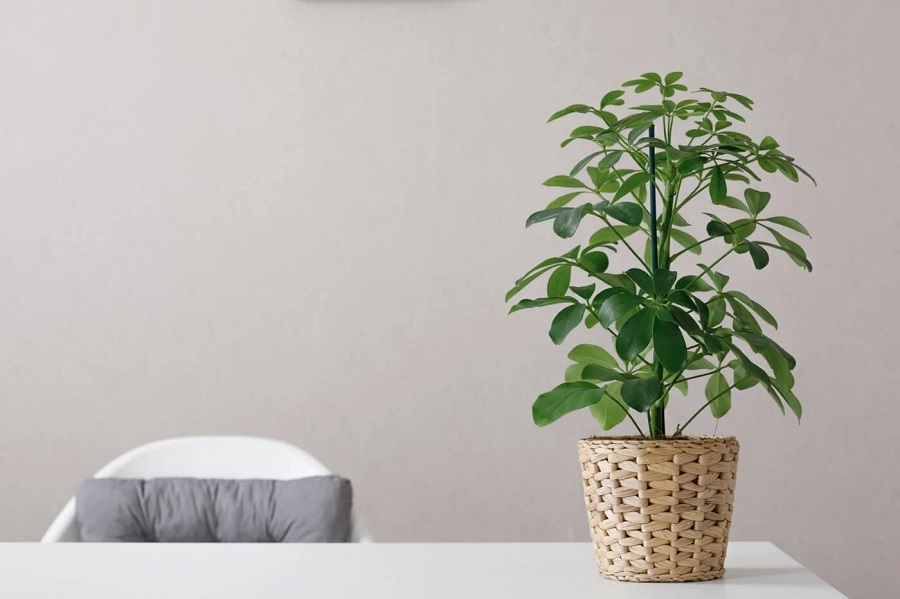
Schefflera - propagation
There are two methods for propagating a shefflera tree. Cuttings from the top of the plant is the easiest way. The best time for this type of propagation is between March and April. Place the cutting in moisture and wrap it in plastic.
The cutting need 4-6 weeks to develop a proper root system. That’s when you can unwrap it and plant it in a pot.
The other method is much more time-consuming. Find a young shoot on the plant and take the bark off from a 10-15-centimeter section. Press some soil or moss to the exposed place and wrap it with aluminum foil. You can secure the foil with a string to make sure it doesn’t fall off. After a few months, roots should appear on the exposed section. Cut the shoot off in autumn and plant it in a new pot.
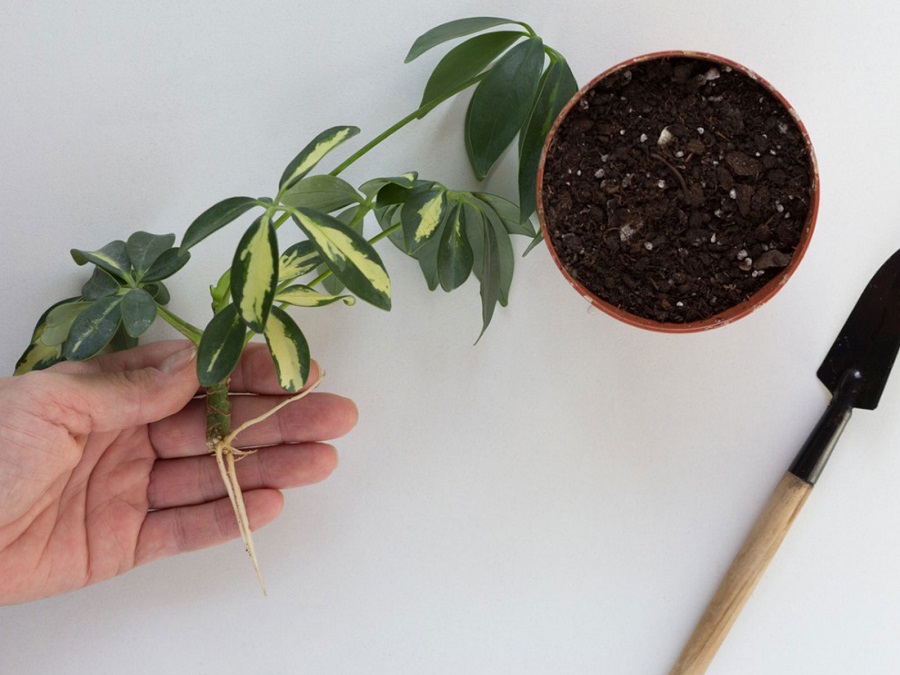
Does schefflera need pruning?
Thanks to skillful pruning, an umbrella tree can develop a lot of branches. Trimming should be done in spring or summer. If you want to shape the plant to your liking, make sure to start regular pruning when your octopus tree is young. Cut only tops of the upper branches. Interestingly enough, schefflera plant (especially dwarf umbrella tree) is often shaped into a bonsai. In this case, trimming should be done in accordance to one of the certain acknowledged patterns.
Umbrella plant problems, pests and diseases
Diseases are a problem of scheffleras just like of other plants. Bacterial infections are the most common issues. They are easy to notice by observing the leaves of an umbrella plant - small spots might appear on them. Bacteria called Pseudomonas cichorii cause brown watery spots. As the disease develops, the spots grow larger and turn black - the plant begins to drop its leaves.
Umbrella trees are also vulnerable to fungal diseases. Alternaria blight is one of the most common problems. It’s caused by Alternaria panax. Round brown spots on leaves are the main symptom. A yellow ring around them often occurs. The spots might spread onto the entire plant in a matter of days.
In addition to bacterial and fungal diseases, an umbrella tree is also vulnerable to pests. Spider mites are the most common ones. The insects feed on the bottom of leaves, making them yellow. You can also observe a delicate web on the surface - it’s very characteristic of spider mites.
If your umbrella tree has been affected by bacteria, fungi or pests, secure it and act quickly to remove the threat. Make sure to use a product against the particular problem to resolve the issue.
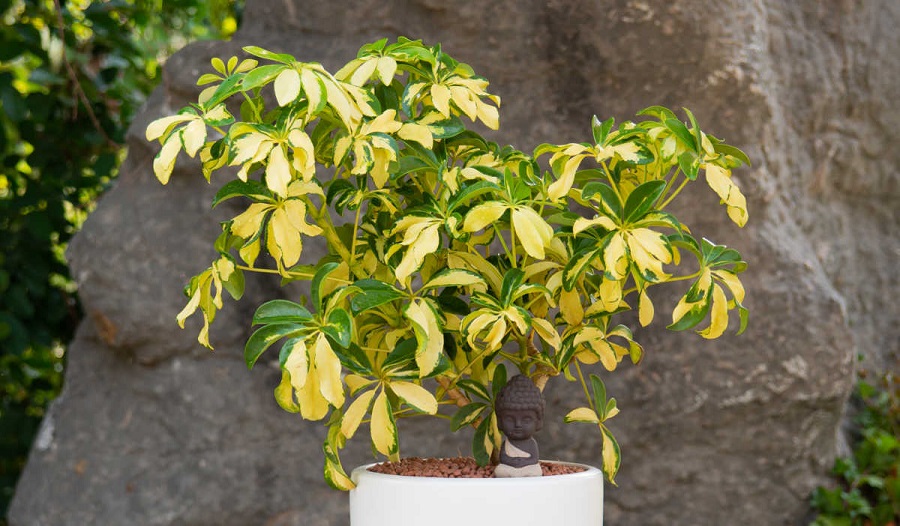
📍 What does an umbrella tree look like?
Umbrella tree, or schefflera has dark green and shiny leaves - they can be even 20-centimeter long. The whole plant can get up to 1.5 meters.
📍 Schefflera - what is the best soil for the plant?
If you decided to get an umbrella plant, make sure to plant it in the right soil - of pH between 5.5 and 6.5. Peat moss substrate or special soil mixes are commonly used for plants of this type.
📍 How to propagate an umbrella tree?
You can propagate a schefflera in two ways. One of them involves rooting cuttings taken from the top of the plant. The second method is preferred by expert gardeners, and it's done by wrapping a section of the plant to make it develop a new root system.
📍 How to prune an umbrella tree?
You should prune a schefflera because it's a lignifying plant. As gardening practice indicates, you should treat the plant just like garden shrubs. Cut the shoots only over a bud or on a branch split.
Featured articles




